New Accord takes on midsize challenges
By John Gilbert
The Honda Accord has 36 years rising to prominence and staying there through eight generations, atop the midsize car segment. Things have changed. The completely redone 2013 Accord is just hitting showrooms in mid-September of 2012, and for the first time it faces unprecedented pressure to maintain its status.
At first glance, or more accurately first drive, the new ninth-generation Accord seems quite well equipped to hold its ground, with a smaller size for agility, and new engines and transmissions for improved fuel economy. The question is, does the Accord do enough to turn back cynical accusations that it has been slumbering for a decade, leaving the door open for competitors to catch, or pass it on the open road?
The first generation of the Accord was sold from 1976-81 and was built in Japan. Generation changes came in 1982, with the opening of the Marysville plant, and followed in 1986, 1990, 1994, 1998, 2003, 2008, and now, 2013.
The first seven generations broke an impressive trail. The eighth generation is the one that turned off some Honda loyalists, and therefore provides the challenge for the new car. Honda debated whether to make the eighth-gen car smaller, keep it the same size, or make it larger. There was some who wanted to reduce its length to make it more agile, but when Toyota introduced a new and larger Camry, Honda decided to make the 2008 Accord the largest car in the midsize category.
The current Accord has maintained its financial success, ranking No. 2 in retail sales through the first eight months of 2012, despite aging into its fifth year. But being larger, bulkier, less agile and less fuel-efficient also gave several competitors a good target. Hyundai with its 2011 Sonata, soared in popularity with a highly efficient 2.4-liter direct-injected 4-cylinder engine that raised the standards of power and fuel economy in the segment, and the new Camry, Nissan Altima, Chevrolet Malibu, Ford Fusion and others rallied to raise their standards, too.
Honda has addressed those competitors with the 2013 model, which has an overall length of 191.3 inches — 3.6 inches shorter than the current car — on an inch-shorter wheelbase of 109.3, yet increases interior room. The more stylishly sculptured form is filled with features and new technology, including a new hybrid system at the top of the model array.
Shoji Matsui joined Honda 30 years ago, just in time to work on the 1986 Accord, and he designed the new Accord. He said the new car, has “all the power of Honda, with no excuses. The sedan has the winning formula of universal styling, that will never get old. We didn’t want high side sills,” he added, without mentioning the Chrysler 300, Dodge Charger, Ford Taurus, or others that have that design.
During the first walk-around at the Accord introduction in August at Bacara Resort in Santa Barbara, Calif., a Honda design expert said making the Accord smaller outside with shorter length and wheelbase makes it more agile. I expressed skepticism No. 1: Did Honda designers just learn that, or did they purposely make the current model less agile?
Accords come in LX, a new Sport level, EX, EX-L, and the loaded EX-L Navi. The price range for the 2.4-liter 4-cylinder models is from $22,470 for the basic but well-equipped LX, $24,180 for the Sport, $25,395 for the EX, and up to $30,785 for the top EX-L with navigation. Choosing the 3.5 V6 will cost from $30,860 for the EX-L, up to $34,220 for the Touring sedan.
The Accord Coupe is its own car now, also on a new chassis, with what Matsui called “an athletic and premium interior,” and a rear seat specifically targeted to be roomy enough to actually house occupants under the fastback roofline. At 188.6 inches, the Coupe is 2.7 inches longer than the sedan, while its 107.3-inch wheelbase is 2 inches shorter than the sedan.
My sarcasm No. 2 antenna was already up because I had heard about the “all-new 2.4-liter 4-cylinder base engine.” Hondas have been powered by a 2.4-liter 4 since 1998, and when engineers stuffed the 2.4 from the Acura TSX into the smaller Civic Si unchanged, PR types called it “all-new” too.
Then I met Yasuhide Sakamoto, the chief engineer on the Accord powertrains, and Sakamoto’s credibility clicked on and my skepticism clicked off with his first answer to my first question: What was his previous role at Honda? He said he had been chief engineer of Honda’s Indy Car racing engines. For those who don’t follow racing, Honda’s Indy Car engine program was so dominant that Chevrolet and Toyota withdrew a year after Honda came into the series, and for six consecutive years all 33 starters at the Indianapolis 500 were Honda-powered, until rule changes this year required new engine configuration.
Clearly, this was not just a marketing guy trained in PR-speak. Sakamoto said he switched to overseeing the new Accord engine three years ago, and finds a great similarity in objectives.
“The new Accord 2.4 has a new crankshaft, new pistons, new cylinder heads, new valve angles, and even the new intake manifold and valve covers, which are now made of resin,” said Sakamoto. “It has a new block, made of different material, and while the spacing between cylinders is the same, it has a different bore and stroke. The emphasis was on improving weight and rigidity.
“Engines have a common area, like a mind,” he added, sounding like he might have been dictating a Honda engineering proverb. “Indy Car engines need more power, but the things we needed to do on this engine are basically the same.”
The addition of direct-injection, which controls the precision and pressure of the fuel injected directly to each cylinder, helps raise horsepower in the 2.4 to 185, and 189 if you select the Sport, and both have 181 foot-pounds of torque. The new 4-cylinder gets the nickname “Earth Dreams,” which nobody would admit or deny was Honda’s reaction to Mazda, which calls its thoroughly revised new engine technology “Skyactiv.”
I was able to heckle Sakamoto that the now-3-year-old Hyundai 2.4 GDI engine produces 200 horsepower, but his new engine is at least in the ballpark. EPA fuel estimates for the Accord 4-cylinder are 27 city and 36 miles per gallon highway. My driving partner and I were able to record from 27.8 to 32.1 mpg in combined driving, with the 6-speed stick. That should make the Accord competitive with Altima, Fusion, Camry and Hyundai Sonata/Kia Optima, although I’ve personally gotten 40 mpg with the Sonata. All of them, along with the new Chevrolet Malibu, are going strictly with 4-cylinder engines for 2013, while the Accord will continue to offer a 3.5-liter V6 alternative.
With VTEC variable valve-timing and cylinder deactivation at cruising speed, the 3.5 V6 has 278 horsepower (a gain of 7) and 252 foot-pounds of torque (an 18-percent increase), and it gains 4 mpg, up to 34 in highway driving.
The V6 sedan comes only with a 6-speed automatic, while the Coupe comes in either the 6-speed manual or 6-speed automatic. I mentioned to Sakamoto how much I liked the late and lamented Honda S2000 sports car, and he asked me to try the new 6-speed in the Accord and compare the shifting. I had to tell him he was right. The stick has an easy-to-operate clutch and the shift lever snicks from gear to gear with sporty, short-throw ease. That 6-speed manual transmission, by the way, transforms the Accord Coupe into a true sporty car.
I liked the 4-cylinder Accord with the new 6-speed manual, too, and I was impressed with its alternative automatic, a new and impressive CVT — continuously variable transmission. It avoids what Honda engineers say is the “rubber band” feeling of most CVTs. Sakamoto said the mechanical CVT has a greater torque-range than the Civic, with its smaller CVT, or the Insight, which has an electric CVT. “We made it efficient, sometimes for speed, and sometimes for fuel economy,” he said. “It’s all in the softwear. If you shift to ‘S,’ which is the sports mode, it holds a little more revs.”
The CVT on the Sport model offers paddle switches on the steering wheel for manually selecting different tensions on the CVT pulleys, simulating six different gear changes.
Handling is good with the new Accord, partly because of the more compact design perhaps, with much credit going to a structure comprised of 55.8 percent high-strength steel, up from 44 percent, which alone reduces weight by 551 pounds. A unique steel-aluminum bonded subframe adds to the feeling of stability. Product planner Art St. Cyr said the new car’s handling was improved by the combination of its new electronic steering and MacPherson struts, which replace hydraulic steering and double-wishbone suspension. I flinched, at what I perceived to be PR-speak, which caused Sarcasm Part 3 to rise up. I’m convinced the double-wishbone set-up is the best for precise handling on race tracks or highways. And I don’t believe Honda ever abandoned the costlier double-wishbones on its Indy Cars, or from the late 1980s, when Hondas were winning three Formula 1 championships. My question went unanswered, but if the new electronic steering is so good it compensates for the loss of double wishbones, it must be very good indeed.
As if the various new Accord sedans and Coupes with their different engines and transmissions weren’t enough, the Accord also has a new Hybrid model. Honda tried that once before, but used its V6 combined with a battery pack, which had a lot of power but not much mileage, compared to the Toyota Camry, which used a 4-cylinder in its hybrid. Honda discontinued the Accord hybrid, but is back in higher-tech form for 2013.
It now uses a 2.0-liter Atkinson-cycle 4-cylinder engine, which has specifically altered valve timing, and a high-output lithium-ion battery pack. Combined, the electric input boosts the gas engine’s 137 to 196 horsepower, and the 122 foot-pounds of torque are to 226. A plug-in hybrid will follow shortly. In a short loop at the Accord introduction, I attained 41.7 mpg in the Accord Hybrid.
The new Honda system will run in EV (electric vehicle) mode, using only electrical energy from the battery to the drive motor, with electrical energy coming from the engine generator to the drive motor, assisted by the battery. But the gas engine can also directly power the wheels, unlike the Toyota system where the gas engine alone never powers the car.
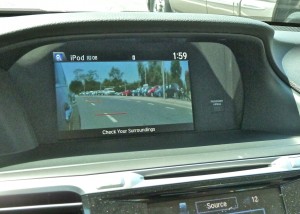
Freeway specialty: Right outside mirror transforms a video image to the nav screen displaying two lanes of traffic.
The Honda’s gas engine keeps the car going, of course, but the strict EV range of the Honda plug-in hybrid is only 10-15 miles, which is less than the Prius plug-in or the Chevrolet Volt. But the Accord’s charging recovery is much better than either, gaining 8 miles of EV power with only 30 minutes of charging. Honda says its plug-in hybrid system will be offered on both 4 and V6 engines, and a two-motor hybrid will be following.
If styling alone can’t improve the Accord’s status, it has enough technology to carry the load.
Comments
Tell me what you're thinking...
and oh, if you want a pic to show with your comment, go get a gravatar!


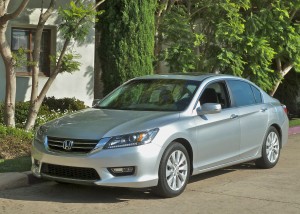
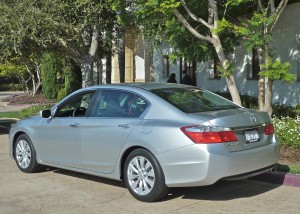
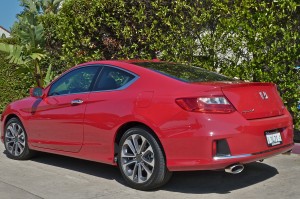
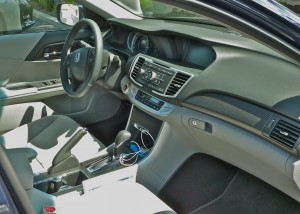
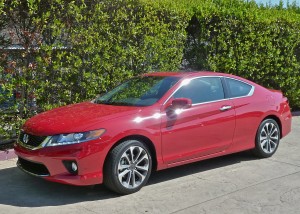
 John Gilbert is a lifetime Minnesotan and career journalist, specializing in cars and sports during and since spending 30 years at the Minneapolis Tribune, now the Star Tribune. More recently, he has continued translating the high-tech world of autos and sharing his passionate insights as a freelance writer/photographer/broadcaster. A member of the prestigious North American Car and Truck of the Year jury since 1993. John can be heard Monday-Friday from 9-11am on 610 KDAL(www.kdal610.com) on the "John Gilbert Show," and writes a column in the Duluth Reader.
John Gilbert is a lifetime Minnesotan and career journalist, specializing in cars and sports during and since spending 30 years at the Minneapolis Tribune, now the Star Tribune. More recently, he has continued translating the high-tech world of autos and sharing his passionate insights as a freelance writer/photographer/broadcaster. A member of the prestigious North American Car and Truck of the Year jury since 1993. John can be heard Monday-Friday from 9-11am on 610 KDAL(www.kdal610.com) on the "John Gilbert Show," and writes a column in the Duluth Reader.